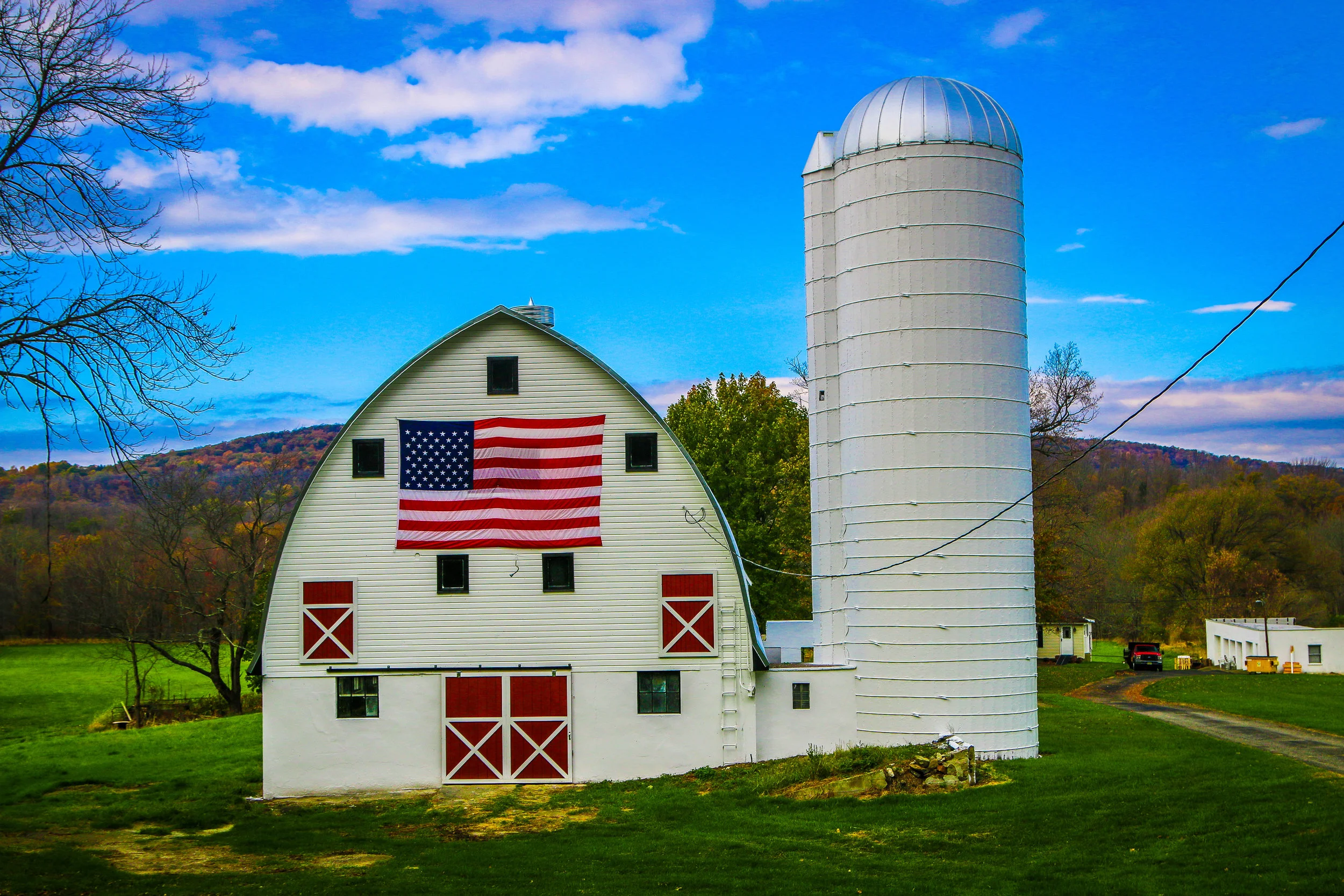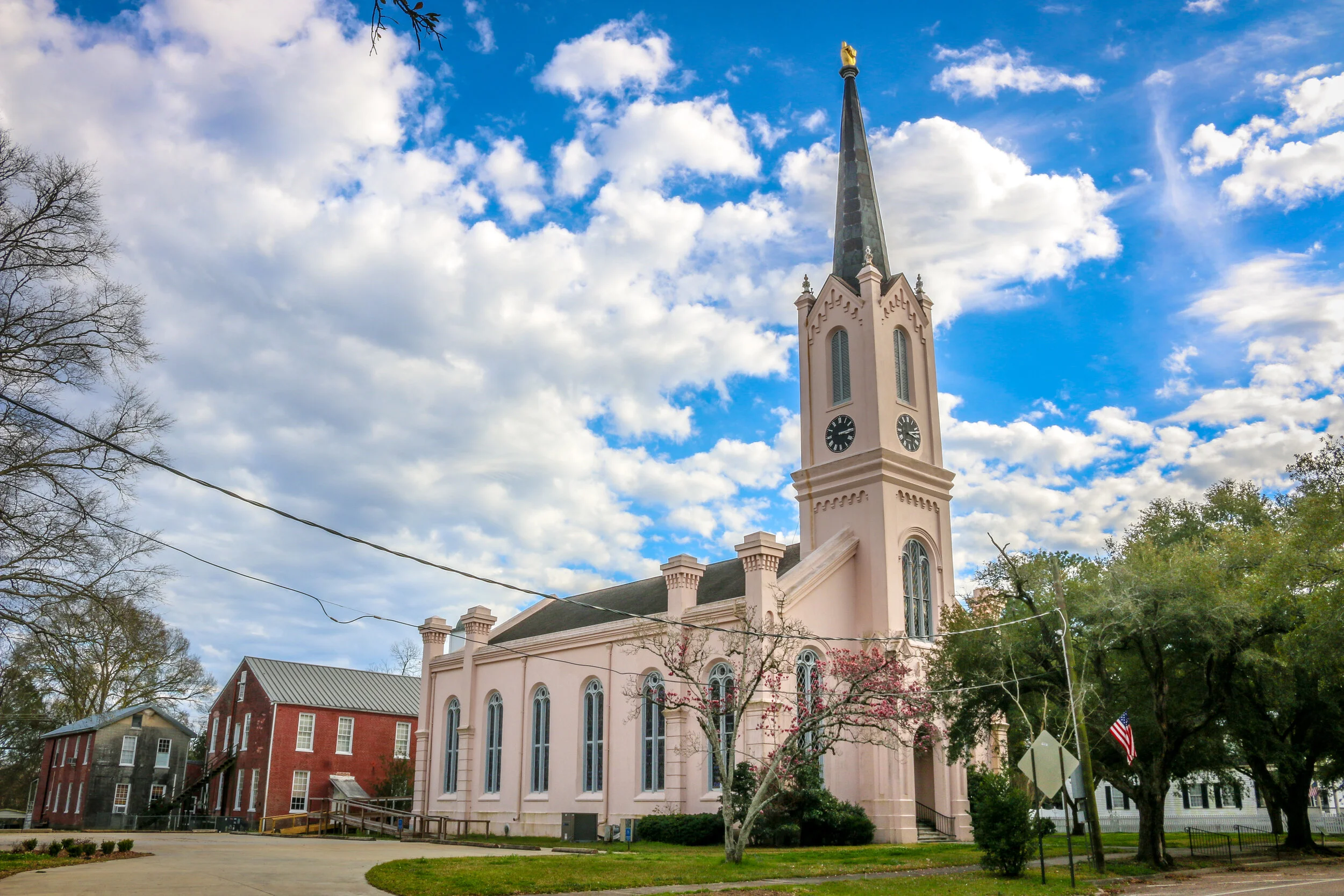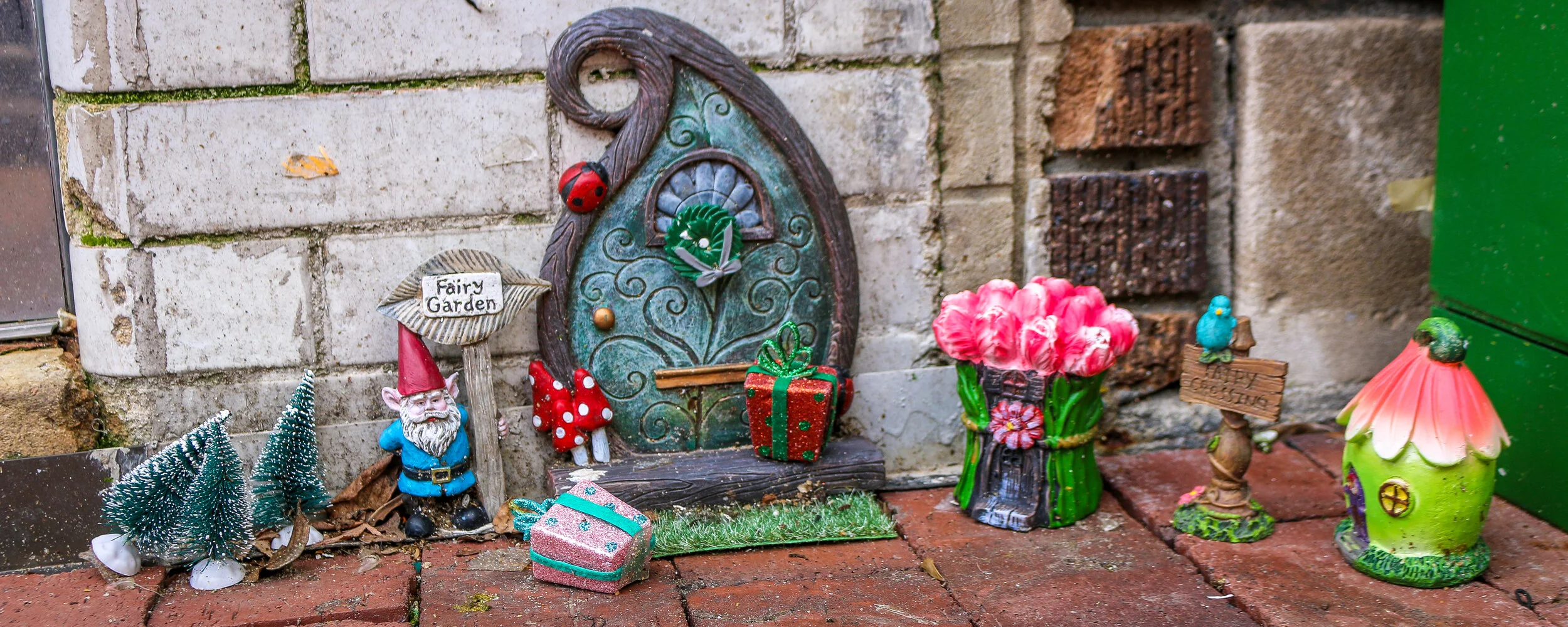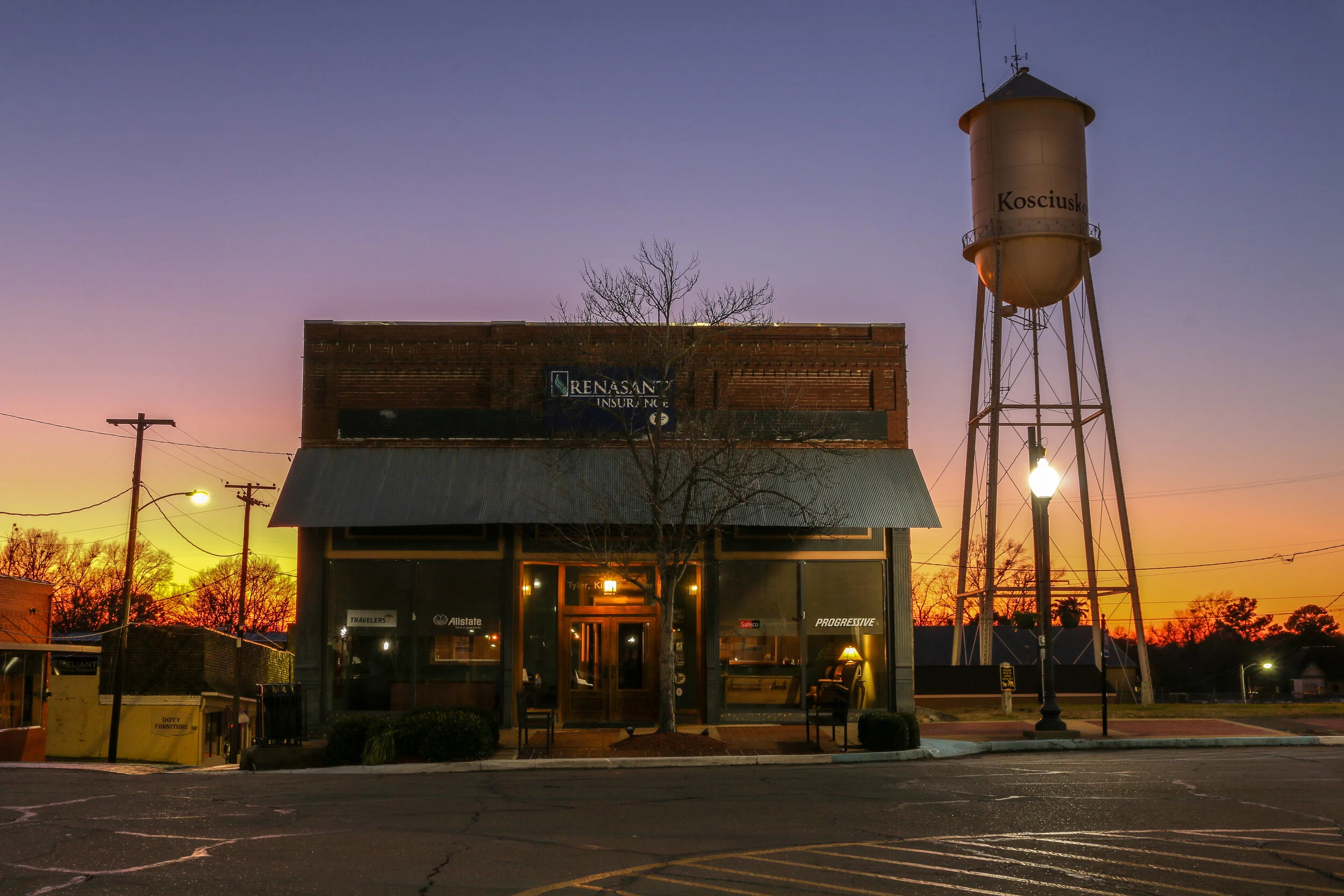Founded by French colonists in 1729, Port Gibson is one of the oldest towns in what’s now the state of Mississippi. Today, it serves as the county seat of Claiborne County and it is home to the beautiful county courthouse pictured below. Port Gibson was the site of several skirmishes during the Civil War, but most of its antebellum buildings survived because General Ulysses S. Grant called the town “too beautiful to burn”. The town’s population today is probably only around 1500 which explains why it’s so quiet. There are several beautiful old churches along the appropriately named Church Street and some great old buildings around the downtown area. I really enjoyed the wonderful, sunny afternoon I spent taking these photos in the charming town of Port Gibson.
Viewing entries in
Photography
If you know me, you know how much I love the Mississippi Delta. There is just something special in the air out there. The people, the music and the food are all incredible, and the landscapes and buildings captured my heart long ago. I know that it’s an incredibly impoverished region, and that part of what makes it beautiful is the decay that goes along with this poverty. I also know that this decay is part of what brings out tens of thousands of tourists every year and they make their ways down the Blues Trail, Country Music Trail and Freedom Trail, in search of real an authentic Delta experience. Making that work is a challenging balancing act. Places like The Shack Up Inn in Clarksdale and Tallahatchie Flats in Greenwood do a remarkable job of finding that balance. Many of these photos are from those two places. Some of these photos are dated - Po’Monkey’s doesn’t look anything like it does in these photos anymore after the passing of its proprietor Willie Seaberry, but the way it used to look is how I’ll always remember it. You’ll find that dusk is definitely my favorite time to be out taking photos in the area. I’ve been coming to the Delta for over a decade now, and I’ve seen a lot of changes - many for the better, some for the worse. Either way, it’s a place that keeps pulling me back, and every time I’m there I find some new treasure. I hope you enjoy these photos which represent some of the highlights of 10 years of traveling the region. They are my favorites.
Hey y’all, it’s time for another edition of This Week on the Road. It’s going to be a short one this week because I only really spent the first couple of days of the week on the road. Since Saturday I’ve been relaxing here in New Orleans, spending time with my friends and enjoying the Mardi Gras weekend. I did have a great few days along the coast to wind up my time in Mississippi though, and wanted to share what I got up to out there.
My week started in Pascagoula in the rain, but I quickly moved on to Ocean Springs. I really liked this quaint and quiet seaside town with its thriving artists community, pleasant bars, and good restaurants. It seemed like a vibrant and livable place. My first stop was a restaurant I’ve wanted to get to for a while: The Shed Barbecue and Blues Joint. The Shed is a South Mississippi Institution, and occupies a huge, ramshackle building just north of the interstate. The Shed is the kind of place that chains have been trying to emulate for a long time, but with little success. The place is full of old beer and traffic signs, mismatched furniture and dollar bills hanging from the ceiling. It’s the real deal though with great food, wonderful employees and an all around good feel to it. I went with the ShedHed Sampler which came with all seven of their smoked meats and three sides. For $26 I didn’t expect too much, but what came out was amazing. It was a tray piled high with food, enough to fill me up that night, and also for lunch and dinner the next day as well. It was a great meal and experience and I will definitely come back to The Shed in the future. After dinner, I went for some live music and a few beers at the Glory Bound Gyro Co. on Government Street. It was a little chilly, but not too cold to enjoy the outdoor seating area which had a beachy feel to it. I sat by the palm tree and enjoyed some acoustic music there, and later popped in for a quick beer at a place called The Juke Joint. I really liked this divey bar in a hundred year old house a mile or so from the main part of downtown as well.
I didn’t really intend to be in New Orleans for Mardi Gras this year, but after getting a late start from Washington in January and spending more time in Mississippi than I had planned, the stars aligned and I found myself pulling into New Orleans on the Saturday of Mardi Gras weekend. Normally when I’m here for Mardi Gras, I come to town at least week early to catch some of my favorite parades, see some friends, eat some of that great New Orleans food and enjoy myself. By the time Fat Tuesday rolls around, I’m already pretty tired from all of the lead-up. This year, I was still pretty fresh for the big day, and I wanted to experience some of the traditions I had either never seen before, or not experienced in the way I wanted to. I kept a loose plan in my head and allowed myself to go with the flow, warning my friends that I might break off at any moment and go a different direction. This all allowed me to have an amazing Mardi Gras, see some different sides to the experience, and gain a better understanding of the traditions of the day. I thought I’d share my my Mardi Gras with y’all in this post.
Greenwood, Mississippi is a friendly place. So friendly, in fact, that the city has welcomed a small but growing population of Fairy Gnomes to town. I inquired at the Visitor’s Center as to when the Fairy Gnomes started arriving, but was told they just showed up one day. Nobody knows where they came from or when a new group may arrive and build a tiny door to their tiny world. It seems the Fairy Gnomes do get into the spirit of the holidays though, and when I was visiting some still had their Christmas decorations up. That’s okay, so did my brother. These tiny citizens keep out of the way, and you might find their homes difficult to spot. I know I sure did. Even with a list of their addresses in hand, some took considerable effort to find. I also found a couple not on the list, so maybe their population is growing. I love everything about the Fairy Gnomes of Greenwood. They reminded me of the Mice on Main Project in another of my favorite towns: Greenville, South Carolina. I always think it’s great when a town remembers that all of its citizens aren’t adults and that a little wonder can go a long way in the world of a child.
Greenwood, Mississippi captured my heart the first time I visited it a little over four years ago. As I pulled over the bridge into the heart of downtown, I found quiet streets, well maintained historic buildings, wonderful restaurants steeped in tradition and some of the friendliest people in the world. Since that first visit, I’ve returned as often as I could, sometimes just to enjoy a nice meal, wander the beautiful downtown area and sit by the river and read my book. There are even speakers on the streets around town providing a soundtrack to the city, something I always forget until I’m there and then it has me grinning from ear to ear. Greenwood is called the Gateway to the Delta, and is truly one of the nicest towns not just in Mississippi, but in the entire South.
The land on which the city of Greenwood now sits was once Choctaw Indian land, but was ceded to the United States by the Treaty of Dancing Rabbit Creek in 1830. The Chief of the Choctaw at that time was Greenwood LeFlore, from whom the town would take its name. Greenwood would become prosperous as a shipping town, transporting cotton to markets in St. Louis, Memphis and New Orleans. When the railroad came through in the 1880s, it would cement Greenwood as a transportation hub and a cotton center of the region for years to come. Today, Greenwood is home to the Viking Range Corporation, a major employer in the city. Viking has done a great job of utilizing many of the historic buildings in town instead of knocking them down and building new ones, leaving the downtown area’s historic charm intact. The 2011 film The Help was filmed in Greenwood, as was the 1991 Denzel Washington movie Mississippi Masala. I’m surprised more movies haven’t been filmed here as it really is a quintessential small Southern city…
Hello Everyone! It’s been another amazing week on the road, dodging the rain, learning some history and thankfully catching some breaks in the weather to get some cool shots of some wonderful small towns as well. I’ve got a lot of photos that need to be edited and published, but I’ve really enjoyed taking them and am looking forward to getting to them ASAP. This week started in Vicksburg, took me down to the one-time State Capital of Natchez, up the Natchez Trace Parkway through Port Gibson to Jackson, east to Meridian, northwest to the Choctaw Indian Reservation and then due south to the coast here in Pascagoula. It’s been a busy week with lots of miles clocked, but I’ve seen some amazing places along the way. I want to give a big shout-out to one of my readers, Todd, who gave me a lot of suggestions for this week, all of which were spot-on. Thanks Todd!
After I left y’all last week, I had a pretty quiet night there in Vicksburg. Thursday morning I woke up early and headed straight for the Old Courthouse Museum high above town. I had a nice chat with one of the men working there as I entered, and then had a great long wander through the collection. I realized at some point that I had been there before, but it’s been at least a decade. I really enjoyed it. There was a hammer made from the wreck of the Star of the West, some original Dix banknotes (Dix is 10 in French, and people used to say they had some “dixies”, which then offered up “Dixieland” and the rest is history), the tie Jefferson Davis wore at his inauguration, an original Teddy Bear presented to a local child by Theodore Roosevelt himself and so much more. The courtroom itself has been nicely preserved, and I loved the swivel seats for the jury – it was probably all the rage when they were installed in 1890…
Winona, Mississippi got its start when Colonel O.J. Moore arrived from Virginia in 1848 and established a plantation in the area. When the Mississippi Central Railroad came through in 1860, they bought a part of Moore’s land and ran tracks which would eventually become part of the Illinois Central Line from Chicago to New Orleans. Moore sold some more land around the station and a few businesses sprung up to serve the rail travelers. When the town was incorporated in 1861, they chose the name Winona, which is apparently the name an Indian Chief would give his first-born daughter. After the Civil War, Montgomery County was organized, and Winona was chosen as the county seat. While the trains no longer pass through Winona, it still sits at the crossroads of highways 51 and 82 and is just a short distance from Interstate 55.It also rests right between the Delta and the Hills regions of the state. Winona has often been called the “Crossroads of North Mississippi”, but I’ve also seen it called the “Art and Soul of Mississippi”, a nickname which I think I prefer. This Norman Rockwellesque town of about 5000 is definitely full of charm and worth a detour from the highway. I wasn’t there long, but I definitely enjoyed my stay in tiny Winona, Mississippi. I hope you enjoy these photos from my visit.
Central Mississippi geographic names pay tribute to our two most famous foreign-born Revolutionary War heroes. Lafayette County, which has Oxford as its county seat, is named for the French Marquis de Lafayette, and the county seat of Attala County is the tiny town of Kosciusko, named in honor of the Polish-born Tadeusz Kosciuszko. Koscuszko grew up attending military schools in Europe, and in 1776, at the age of 30, happened to be in Paris and heard about the American War for Independence. Making his way across the ocean, he volunteered in George Washington’s Army and would rise to the rank of Brigadier General. There are many lasting tributes to Kosciuszko around the country and the world including a garden at the U.S. Military Academy at West Point, and National Memorial in Philadelphia, an island in Alaska and a wonderful statue in Lafayette Park in my hometown of Washington D.C.
The Mississippi city which now bears his name was once a simple campsite along the Natchez Trace Trail known as Red Bud Springs. At some point, a tavern and blacksmith shop were built to provide for travelers making their way up the Trace. Over time this settlement grew, and would eventually be chosen as the county seat of the new Attala County.
Kosciusko is a friendly and welcoming town which centers around a stunning town square. It gets its nickname, The Beehive of the Hills because it is the industrial and retail trade center of the region (there are beehive sculptures around the square which I mistook as pineapples when I arrived). Kosciusko is probably best known as the hometown of Oprah Winfrey, but bluesman Charlie Musselwhite also hails from the town. As did James Meredith, the first African-American student to attend Ole Miss. I loved my visit to this beautiful little community where I stopped off for the night as travelers have for centuries. It was really quiet when I visited, despite it being Saturday evening, and I almost felt like I had the square to myself. The twilight was perfect for taking these photos, and the sky was a wonderful blue when I went back in the morning. I hope you enjoy these pictures of beautiful downtown Kosciusko, Mississippi - The Beehive of the Hills..
Hi Guys, it’s that time of the week again. It’s been another great week on the road in Mississippi, and I’m happy to share some of the highlights with you here. My week started in Cascilla in the rural center of the state, led me on a quick loop through the Delta with night stops in Cleveland, Clarksdale and Greenwood and is ending right here in beautiful but rainy Vicksburg. It’s been a week of beautiful towns, incredible food, good music and some really great photo opportunities. Despite the gloomy weather which has been a pretty constant companion this week, my spirits are high and I’m enjoying myself out here. I’m finding some good balance and trying to stress less and enjoy more. In all, it’s been a pretty awesome week out here.
Storms came hard in Central Mississippi as my week began, with hail, tornadoes and damaging wind. I was grateful to my friend John and his family for giving me shelter from the storm last Wednesday night (and for two nights before that). By the time I left Thursday morning, the worst of the storms had passed although the clouds persisted. Shadow Catcher was a whole different vehicle with new shocks, and we no longer bounce down the road like Tigger. That would come in really handy on the less-than-ideal roads of the Delta. I went with stiffer shocks because it’s a big van, so it’s not a smooth ride, but it’s enormously improved on what it was last week.
Decending from John’s place in the hills and heading west on Route 8, I came out into the beautiful, pancake-flat Mississippi Delta. Cotton fields hemmed in the road, and the familiar sights of rusted out cars in front of old sharecroppers’ cabins made me feel like I was once again on familiar ground…
Columbus charmed me from the minute I arrived. It is a lovely, small city of about 25,000 located in eastern Mississippi on the Tombigbee River. Columbus, called The Friendly City, is the county seat of Lowndes County, and boasts one of the most beautiful county courthouses in the state. It forms one point of the “Golden Triangle” with nearby Starkville and West Point. Founded in 1819, Columbus has some wonderful historic homes, churches and businesses, and won the Great American Main Street Award in 2010. The town briefly served as the Mississippi State Capitol in 1863 when Union forces occupied Jackson. Nearby Columbus Air Force Base is the main driver of the city’s economy, but Columbus is also home to the Mississippi University for Women (called “The W” locally). Playwright Tennessee Williams was born in Columbus, and his birthplace now serves as both a hometown tribute to Williams, and the town’s Welcome Center. Catfish Alley, the city’s old African-American Business District was once a thriving community in which some of Mississippi’s great blues musicians played. Bukka White even wrote a song about the area in 1969 called Columbus Mississippi Blues.. Friendship Cemetery is one of several places in the country which claims the origin of our Memorial Day and has some beautiful and moving monuments and memorials.
Today, you’ll find a quiet and friendly city with some wonderful restaurants, beautiful antebellum homes and a classically Southern, Mississippian and American downtown. Highlights for me were definitely the Stephen D. Lee Home, the Tennessee Williams Birthplace, the cemetery, a stand-alone barber’s pole and just wandering the historic district and seeing the beautiful homes to be found there. I found Columbus to be welcoming and beautiful and really enjoyed my visit. My camera was also very busy during my stay, and I hope you enjoy these photos from my time in The Friendly City of the Black Prairies.
West Point, Mississippi is a pleasant, medium sized town in Clay County in the east-central part of the state. Perhaps best known as the hometown of legendary bluesman Chester “Howlin’ Wolf” Burnett, I found it to be a wonderful place to spend an afternoon. There are some beautiful old buildings, some delightful parks and some wonderful murals and artwork, all packed into a compact and walkable downtown area. Originally home to Choctaw and Chickasaw Indians, the French, Spanish and British also vied for control of the region. The town itself was originally laid out as a railroad town when the Mobile and Ohio Line came through in 1858. It would grow as part of the state’s Black Belt as cotton production became Alabama’s main industry. While I couldn’t find the origin of the name West Point (interesting to me because it’s in the east of the state), Clay County was named for the Great Compromiser, Kentucky’s Henry Clay. Because of the railroad, West Point was a strategic target during the Civil War, although the only real skirmish was a small one and occurred in 1864. November 2nd, 1909 was an exciting day in town when President William Howard Taft’s train pulled into the station and he addressed the townspeople from his rail car before heading on to Columbus.
When I visited West Point, I sadly found the Howlin’ Wolf Museum closed. While I waited for a call back from the man who runs it, I grabbed my camera and went for a wander. While I was there, the clouds cleared and I found a wonderful, clean, well-kept downtown with a distinctly small-town feel to it. I loved the City Hall building, City Park, the town’s stoic churches, the old Ritz Theater, some beautiful art projects scattered around town and some really cute small businesses on Main and Commerce Streets. While I never did get into the museum (they’re building a new one in a vacant storefront on Commerce Street), I’m still glad I stopped. There wasn’t much going on when I was there, and I was okay with that. A beautiful town on a sunny day is always something to write home about. Thanks for a wonderful visit, West Point; I hope to be back when the new museum is open for business.













